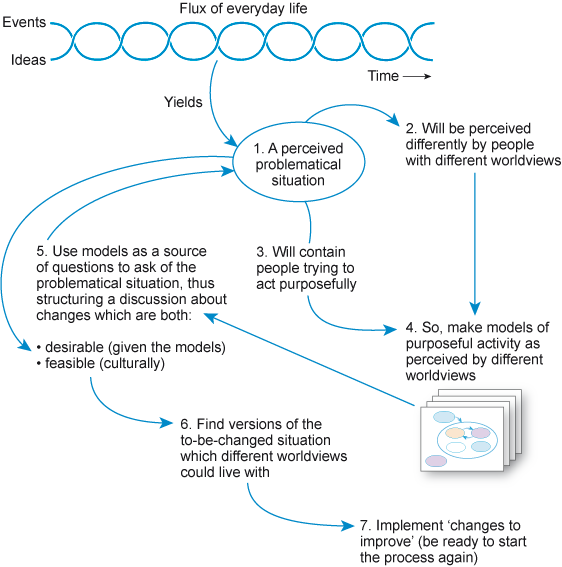TB871: Perplexity and Soft Systems Methodology (SSM)
Note: this is a post reflecting on one of the modules of my MSc in Systems Thinking in Practice. You can see all of the related posts in this category.
‘Perplexity’ is a word that not only feels nice in the mouth, but gains you a decent score in Scrabble. It’s a term which refers to something being puzzling, because a situation is intricate or complicated.
In terms of systems thinking, situations of interest are often complex and ill-defined, and therefore ‘perplexing’. It’s difficult to know what the actual problem is.
My area of practice is community development and wellbeing, within which I have identified various systems, including ‘a system to support education and information.’ Within this, I have identified a system to support lifelong learning in the context of library services.
Libraries cater to a broad spectrum of community members, each with unique requirements and expectations. The sheer diversity involved, especially in an increasingly multicultural landscape can make it challenging to point to a particular ‘problem’. For instance, library staff might focus on providing comprehensive resources, while what community members might want a whole range of diverse services from study support to social gatherings.
Resource constraints can further complicate this situation. Limited budgets and staffing can lead to conflicts around prioritisation, making it difficult to maintain up-to-date resources and technology. Additionally, the rapid pace of technological change necessitates continuous updates and training, which can strain already limited resources.
In this kind of situation, it’s difficult to know how to move forward. There are different needs and agendas of stakeholders, and these can often clash. For example:
- Library staff: aim to provide a broad range of resources and programmes, but face constraints in funding and personnel.
- Community members: have diverse needs such as job skills training, study support, and educational support for children.
- Local government: focuses on budget constraints and measurable outcomes, potentially at the expense of innovation.
- Educational institutions: seek collaboration for resource sharing and support for students, which may not always align with the library’s broader community focus.
These conflicting priorities can lead to misunderstandings and a lack of coordinated effort, making it difficult to define and address the core issues effectively.
Soft Systems Methodology

The module materials describe Soft Systems Methodology (SSM) in the following way:
SSM is an approach developed by Peter Checkland to address complex problematic situations applied across a wide set of domains where part of the perceived issue is that the problem defies definition. More explicity, SSM is a ‘methodology’ (in contrast with VSM, which is a ‘model’). This ‘methodology’ is like a ‘recipe for action’ – a set of instructions to follow for carrying out agreed action – in a complex situation of interest. The recipe is not, however, a fixed method, but rather it is a flexible framework within which you can follow your own path.
[…]
From a STiP perspective, methodology can best be described as the ‘conscious braiding together of theory and practice in a given situation, as a context specific enactment’ (Ison, 2017, p. 167, italics added). So for our purposes SSM, whilst nominally called a methodology, can best be understood as ‘a methodological approach’, where its application in specific contexts with or without other tools can be understood more specifically as methodology.
(The Open University, 2020)
In a library context, therefore, we need to do at least a couple of things:
- Make boundary judgements: we need to decide what to include (i.e. what to prioritise) and what to exclude (i.e. what can be deprioritised, being addressed later or not at all)
- Engage multiple perspectives: to gain a holistic view of the situation, we need to acknowledge that each stakeholder’s viewpoint contributes to a more comprehensive understanding of the problem.
SSM is ultimately about learning alongside stakeholders, trying something which may improve a situation of interest, seeing what happens, and then continuing along that path, or trying something else.
References
- The Open University (2020) ‘5.1.1 Problems and perplexity’, TB871 Block 5 Tools stream [Online]. Available at https://learn2.open.ac.uk/mod/oucontent/view.php?id=2261499§ion=2.1 (Accessed 8 August 2024).
